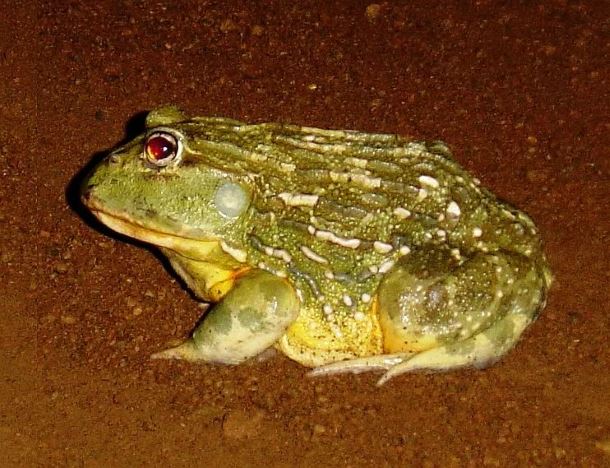Each year, hundreds of Giant Bullfrogs cross busy roads in an attempt to reach their breeding sites, putting themselves at great risk. The Endangered Wildlife Trust (EWT) is asking you to keep your eyes peeled while on the roads this rainy season, and brake for bullfrogs.
The Giant Bullfrog is the second largest species of frog in the world, and an iconic species in Gauteng, which is the stronghold of their distributional range in South Africa. Loss of grassland and pan habitat within this rapidly urbanising area is threatening the species’ survival. This includes both the direct impacts of roads, such as being killed by vehicles and the indirect impacts, such as being prevented from reaching breeding sites from over-wintering sites. The Giant Bullfrog is also an explosive breeder – emerging from underground burrows where they spend much of the year for only a few weeks in summer.
As a follow-up to the campaign we ran earlier in the year, requesting sightings information from the public, the EWT is continuing its work to help prevent roadkill of this iconic species by informing members of the public when and where the bullfrogs are likely to be active. It is anticipated that November to January will be the next period of activity for the bullfrog and we are calling on members of the public to assist us by being our watchdogs on the roads. If you find a bullfrog on the road, dead or alive, please send us a photograph, the location (preferably GPS coordinates) and road name, as well as the number of bullfrogs seen, to roads@ewt.org.za or submit via EWT’s Road Watch app. Visit the iTunes or Play store to download this app. Additional information is available on www.ewt.org.za. If you find an injured bullfrog, it can still be saved by taking it to the Johannesburg Wildlife Veterinary Hospital (+27 71 248 1514 – 24 hours/ jhbsmallwildlife@gmail.com)
Your reports will assist us in identifying breeding sites and areas that require potential conservation action to reduce bullfrog roadkill. Other plans to protect these animals include modification of under-road culverts and encouraging the bullfrogs to make use of these passages as crossing routes to their breeding sites. Reducing incidences of roadkill of this species will contribute to alleviating the threats facing these animals, and given their high visibility and a short breeding season is a project that could have a high impact for their ongoing survival.
Together, we can make a difference on our country’s roads – will you help?
The EWT’s Wildlife and Roads Project is supported by Bridgestone SA, N3 Toll Concession, Bakwena Platinum Corridor Concession, TRAC N4 and Ford Wildlife Foundation.
Avoid crashing into Animals On The Road https://t.co/m0GeNk6Pgd #ArriveAlive #EarthDay2015 pic.twitter.com/MRD9YBPh9f
— Arrive Alive (@_ArriveAlive) April 22, 2015
